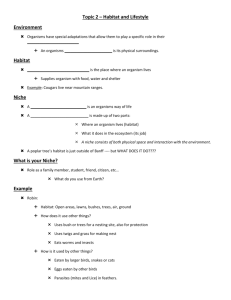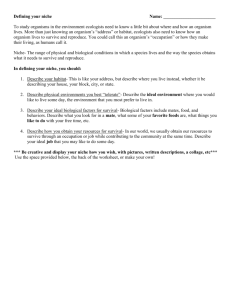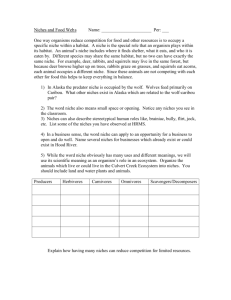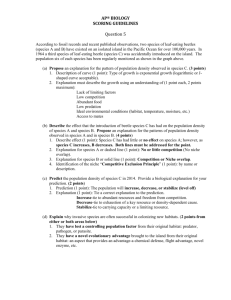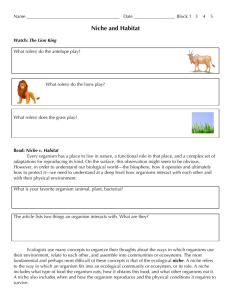Topic 2 – Habitat and Lifestyle
advertisement
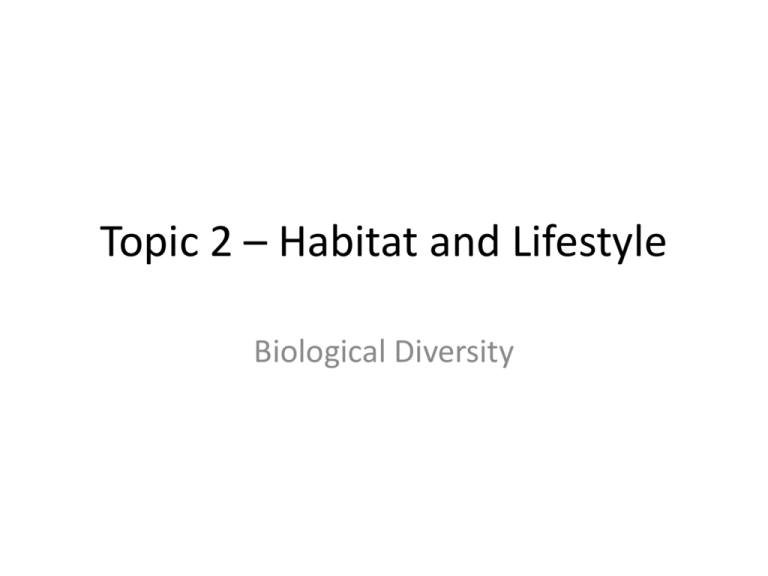
Topic 2 – Habitat and Lifestyle Biological Diversity Environment • Organisms have special adaptations that allow them to play a specific role in their environment – An organisms environment is its physical surroundings. • DESCRIBE YOUR ENVIRONMENT Habitat • Habitat is the place where an organism lives – Supplies organism with food, water and shelter • Example: Cougars live near mountain ranges. • QUESTION: What is your habitat? Niches • A niche is an organisms way of life • A niche is made up of two parts: » Where an organism lives (habitat) » What it does in the ecosystem (its job) » A niche consists of both physical space and interaction with the environment. • A poplar tree’s habitat is just outside of Banff ---- but WHAT DOES IT DO???? Types of Niches • Producers • Consumers – Herbivores, omnivores, carnivores • Decomposers WHAT IS YOUR NICHE? • Role as a family member, student, friend, citizen, etc… • What do you use from Earth? Questions to think about when looking at Niches • Where does it get its food? • Where does it release its waste? • How does it interact with the biotic (living) and abiotic (non-living) environment • How it moves in its environment (how much space it occupies) • How it reproduces • How it changes its environment Example: • Robin: – Habitat: Open areas, lawns, bushes, trees, air, ground – How does it use other things? • Uses bush or trees for a nesting site, also for protection • Uses twigs and grass for making nest • Eats worms and insects – How is it used by other things? • Eaten by larger birds, snakes or cats • Eggs eaten by other birds • Parasites (mites and Lice) in feathers. Example – Your Turn • Describe the Niche of a Salmon – Habitat? – How does it use other things? – How is it used by other things? Overlapping Niches • Overlapping niches means that different species must subdivide their resources (food, living area etc.) – This is done through competition • Variations of different species may give advantages!!! Variation and Competition • When water or food run short, species must compete for it. – Competition can occur between members of the same or different species • Some species may have variations that give them an advantage in competition Example • Cougars hunt large herbivores – Deer, elk, sheep • Cougars and Lynx can live in the same area but… – Lynx will hunt snowshoe hares • WHY? • Changes can happen in species to avoid competition like the cougar and the lynx Example • Mule deer and white tailed deer – Both have the same type of environment (habitat) – Both will compete for food resources • BUT!!!.... Mule Deer are more tolerant to cold winters and White Tale Deer thrive near agriculture areas – Eventually, the better adapted deer will survive and the other will be forced to move or eat something else. Real Life • In one spruce tree, there can be many species of birds – Would there be competition even though they have overlapping niches? – Cape May Warblers live at the top of the tree and feed on insects and spruce bud worms – Yellow Warblers live at the base of the tree and feed on insects and berries – tend to fly away from the tree – Black-throated green Warblers feed near the middle on insects and berries Humans Rule? • For many species, humans are their competitors – What species do we compete with and what resources do we share? – Who do you think is “winning” Survival of the Fittest • Those species well adapted to their environment will survive and poorly suited species die out!! – The best competitors get enough resources to survive and reproduce – The worst competitors do not survive to reproduce – Through the “survival of the fittest” the stronger traits get passed on Avoidance Of Competition • Sometimes species avoid competition by: – Using a different food source – Learning different habits and behaviors • Example: hawks and owls can co-exist and eat the same things ---- why? Broad Niche vs. Narrow Niche BROAD NICHE NARROW NICHE Usually found in Northern areas Usually found in the tropics Few different species of plants and animals but Lots of different species but low numbers of very large populations of the species you do each find (caribou/arctic hare) Adaptations allow species to spread over large areas (found all over the world Have adaptations that allow them to survive in own environment but prevents them from spreading to larger areas Can tolerate daily and seasonal changes in temperature Where food supplies and temperatures are stable Eat a variety of plants or other animals as seasons and conditions change Have one dependable food source, one type of soil or one level of light (increased competition for food) GENERALISTS SPECIALISTS Generalist vs. Specialist • Based on their niche animals will be considered generalists or specialists THE GENERALIST THE SPECIALIST Able to spread over larger areas Adapted to one small area competing for one type of soil or level of light Have many different food sources Have one type of food source Can survive many seasons Need a constant temperature Usually found in large numbers which creates competition Only a few in each area Known to have a broad niche Known to have a narrow niche PROBLEMS??? • Do you see a problem with narrow niche species? – YES!!!!!! – Explanation: narrow niche species fall into the “trap of specialization” Explanation continued… • As the species competes it acquires more useful adaptations – Then the more successful it becomes • HOWEVER… – Its adaptations are focused to living in that ONE environment and prevents it from going anywhere else Examples: • The Lion-Tailed Monkey – Is specialized at living in the forest canopies. » As the forest is continually cut down, it has no where to live since it is not adapted to living on the ground • Giant Panda – Is specialized and only eats ONE thing • Through habitat destruction, they are vulnerable to extinction Some info • Canadian ecosystems lack diversity but support high numbers of the species that live here • Greatest diversity is found in the rainforest followed by coral reefs • The tropics have great diversity but low populations of each species Dependencies between Species • In the competition to survive, many organisms DO NOT work alone. • Some species have a Symbiotic Relationship » Symbiosis: Sym (together) Bios (life) Mututalism • Mututalism is where both organisms benefit from the relationship – Examples: • Elk have mico-organisms that help them digest food. In return, the elk gives the organism a place to live • Clusia flower dispenses medicine to bees and in return they get pollinated Commensalism • Commensalism is when only one organism benefits from the relationship – Examples: • A robin uses a tree for shelter and nesting but the tree does not benefit nor is harmed • Barnacles on a whale Parasitism • Parasitism is where one organism benefits while the other is harmed – Examples • People and tapeworms • Rust and wheat • Spruce tree and pine beetle • http://www.youtube.com/watch?v=jCeyW9m0SXA Introduced species (Bioinvasion) • Humans sometimes things it is a good idea to import a species from one area to another. • Sometimes species move themselves (blown off course or stole aways on a ship). • Bioinvasion is when a new species, somehow, ends up in a new ecosystem and starts to take over Vocabulary from TOPIC 2 • • • • • • • • • • • Environment Habitat Niche Competition Broad vs. Narrow Niche Generalist vs. Specialist Symbiotic Relationship Mutualism Commensalism Parasitism Bio-invasion
